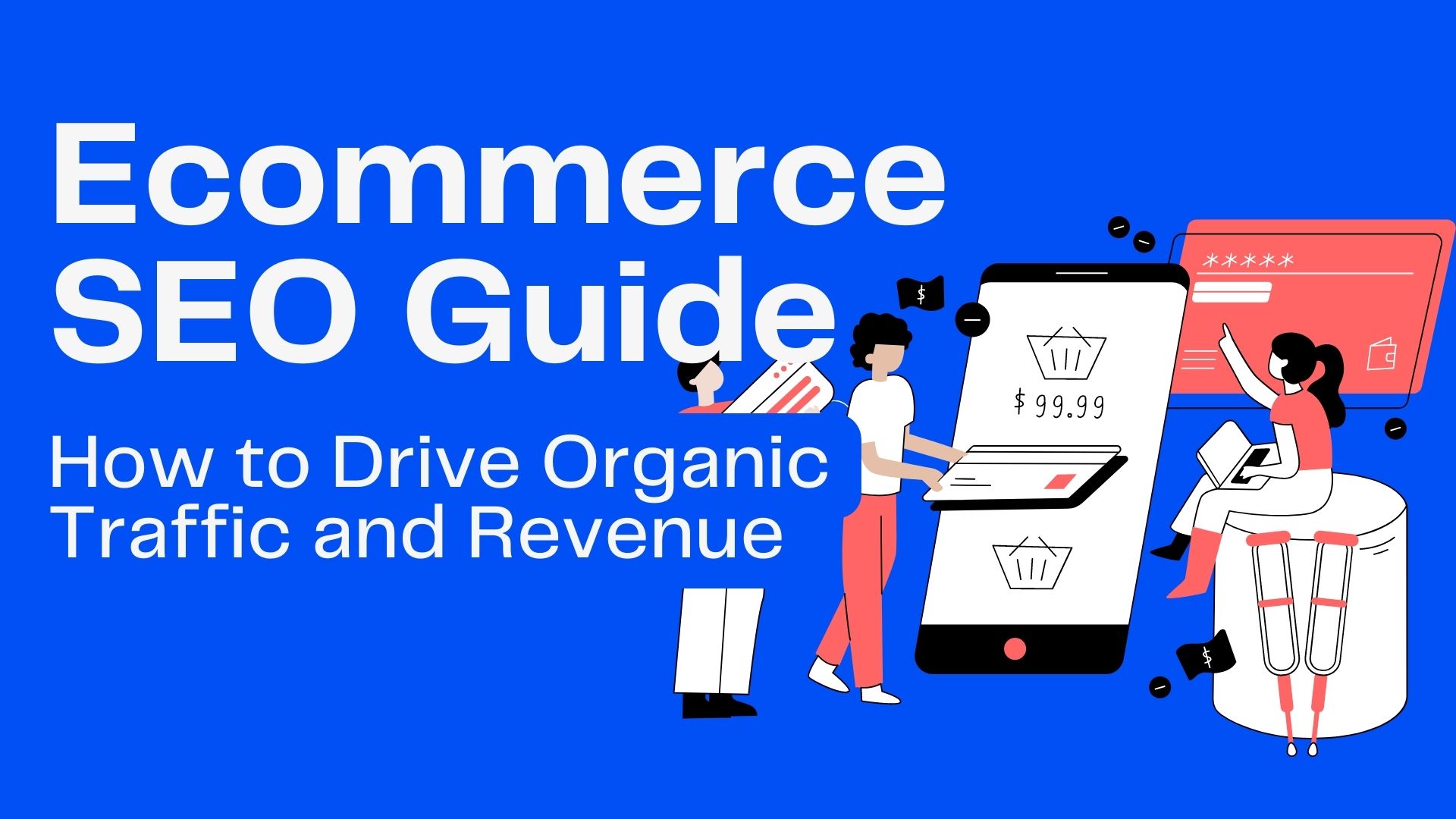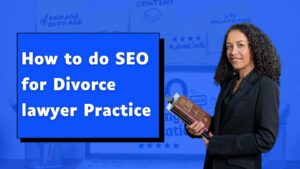Welcome to our comprehensive ecommerce SEO guide! If you’re running an online store, you know how important it is to drive organic traffic and revenue. After all, without a steady stream of visitors, you won’t be able to make any sales.

Here are some of the questions that we will answer in this guide:
- What is ecommerce SEO and why is it important for my online store?
- How do I identify target keywords for my ecommerce store?
- What are the best practices for on-page optimization for ecommerce websites?
- How can I improve my off-page optimization and build backlinks for my online store?
- What technical SEO considerations should I keep in mind for my ecommerce website?
- How do I measure and analyze the results of my ecommerce SEO efforts?
- What are the best strategies for continuously improving my ecommerce SEO and driving organic traffic and revenue?
But what is Ecommerce SEO exactly?
Simply put, it’s the process of optimizing your online store for search engines in order to improve your visibility and attract more qualified traffic.
And why is it important? Well, the more people who visit your website, the more potential customers you have. And the more qualified those visitors are, the more likely they are to make a purchase.
SEO drives approximately 51% of traffic to ecommerce websites. (Source: BrightEdge)
In this guide, we’ll be covering everything you need to know about ecommerce SEO, from keyword research to technical optimization and everything in between. By the end, you’ll have a solid understanding of how to drive organic traffic and revenue for your online store. Let’s get started!
Keyword research
One of the most important aspects of ecommerce SEO is keyword research. After all, if you don’t know what people are searching for, how can you optimize your website to rank for those terms?
To get started with keyword research, you’ll need to identify the target keywords for your ecommerce store. These are the terms that your potential customers are using to find products like yours.
There are a few different ways you can go about finding target keywords.
One of the most effective is to use a tool like Google’s Keyword Planner.
This free tool allows you to enter a seed keyword (such as “women’s clothing”) and see a list of related terms and their search volume.
In addition to using the Keyword Planner, you can also try using a paid tool like Ubersuggest or Ahrefs to get a more comprehensive list of keywords.
These tools can provide you with a wealth of information, including search volume, competition, and even suggested content ideas.
Once you’ve identified your target keywords, it’s time to start incorporating them into your website’s content. This includes product titles, descriptions, and even your website’s meta tags and header tags. By using your target keywords strategically, you can improve your website’s visibility and attract more qualified traffic.
On-page optimization
In addition to keyword research, you’ll also need to focus on on-page optimization to improve your ecommerce SEO. On-page optimization refers to the steps you take to optimize your website’s individual pages for search engines.
One of the most important aspects of on-page optimization is optimizing your product titles and descriptions. These should be written with your target keywords in mind, and should also be informative and compelling for potential customers.
Another important aspect of on-page optimization is the use of header tags and meta descriptions. Header tags (H1, H2, etc.) help to structure your content and make it easier for search engines to understand.
Meta descriptions, on the other hand, are the brief summaries that appear below your website’s title in search results. These should be written in a way that entices users to click through to your website.
Finally, don’t forget about internal linking. Internal linking refers to the practice of linking to other pages on your website from within your content. This can help to improve the user experience by making it easier for visitors to navigate your site, and it can also help search engines understand the structure and hierarchy of your content.
There are a number of SEO tools that can be useful for on-page optimization for ecommerce stores, including:
- Google Search Console: Google Search Console is a free tool provided by Google that allows you to track the performance of your website in search results and identify any errors or issues that may be affecting your search rankings. By using this tool, you can optimize your website’s on-page elements, such as product titles and descriptions, and improve your search engine rankings.
By analyzing the data provided by Google Search Console, you can identify areas for improvement and make changes to your website to drive more traffic and revenue for your ecommerce store. - SEMrush: SEMrush is a paid SEO tool that offers a range of features for on-page optimization, including keyword research, site audit, and content marketing tools. You can use this tool to identify and optimize your website’s on-page elements, such as product titles and descriptions, to improve your search engine rankings.
- Ahrefs: Ahrefs is a paid SEO tool that offers a range of features for on-page optimization, including keyword research, site audit, and content marketing tools. You can use this tool to identify and optimize your website’s on-page elements, such as product titles and descriptions, to improve your search engine rankings.
- Moz: Moz is a paid SEO tool that offers a range of features for on-page optimization, including keyword research, site audit, and content marketing tools. You can use this tool to identify and optimize your website’s on-page elements, such as product titles and descriptions, to improve your search engine rankings.
- Keywordtool.io: Keywordtool.io is a paid keyword research tool that allows you to identify target keywords for your ecommerce store. You can use this tool to identify high-traffic, low-competition keywords that you can optimize your website’s on-page elements for.
- Yoast SEO: Yoast SEO is a free WordPress plugin that helps you to optimize your website’s on-page elements, such as product titles and descriptions, for search engines. It offers a range of features, including keyword optimization, meta descriptions, and readability checks.
- RankMath SEO: RankMath is a popular SEO plugin for WordPress that offers a range of features for on-page optimization, including keyword optimization, meta descriptions, and readability checks. It’s a powerful tool that can help you to optimize your website’s on-page elements, such as product titles and descriptions, to improve your search engine rankings.
Off-page optimization
In addition to on-page optimization, you’ll also need to focus on off-page optimization to improve your ecommerce SEO. Off-page optimization refers to the steps you take to build the authority and credibility of your website through external sources.
One of the most effective ways to build authority and credibility is through backlinks. A backlink is a link from another website to yours. These are important because they help to show search engines that your website is valuable and worthy of ranking highly in search results.
To get backlinks, you’ll need to focus on building relationships with other websites in your industry. This can include guest blogging, participating in online communities and forums, and even reaching out to influencers in your niche.
You can also try using a tool like Ahrefs, SEMrush, or Moz to identify opportunities for backlinks and track your progress.
Another effective way to improve your off-page optimization is through the use of social media. By actively sharing your content and engaging with your followers on platforms like Facebook, Instagram, and Twitter, you can build brand awareness and drive traffic to your website. You can also use social media to connect with potential partners and influencers who can help to spread the word about your online store.
Influencer marketing can also be a powerful tool for off-page optimization. By partnering with influencers in your niche, you can reach a whole new audience and drive traffic to your website. Just be sure to do your research and choose influencers who align with your brand values and target audience.
Technical SEO
In addition to keyword research, on-page optimization, and off-page optimization, you’ll also need to focus on technical SEO to improve your ecommerce SEO.
Technical SEO refers to the steps you take to optimize the technical aspects of your website, such as site speed and performance, mobile-friendliness, and security.
One of the most important aspects of technical SEO is ensuring that your website is fast and performs well. A slow-loading website can drive visitors away and negatively impact your search engine rankings. To improve your site speed, you can optimize images, minify CSS and JavaScript files, and utilize a content delivery network (CDN).
You can use Cloudflare which stores copies of your website’s static assets (such as images, CSS, and JavaScript files) on servers around the world. When a user visits your website, they are served the static assets from the nearest server, which can help to improve the website’s loading speed and performance.
Mobile-friendliness is also crucial for technical SEO. With more and more people accessing the internet from their phones and tablets, it’s essential that your website is optimized for mobile devices. This includes using responsive design, which ensures that your website looks and functions properly on any device.
Finally, don’t forget about security. In the age of online shopping, it’s essential that your website is secure and that your customers’ data is protected. This means using SSL certificates and other security measures to ensure that your website is safe and trustworthy.
You can use Cloudflare as they offer a range of security features, including DDoS protection, SSL certificates, and firewalls, which can help to protect your website from cyber threats and improve its security.
Measuring and analyzing results
As you work to improve your ecommerce SEO, it’s important to track your progress and measure your results. This will help you to identify areas for improvement and test new strategies to continually improve your efforts.
There are a number of SEO and analytics tools that can be helpful for measuring and analyzing the results of your ecommerce store. Here are a few options:
- Google Search Console: Google Search Console is a free tool that allows you to track your website’s performance in search results and identify any errors or issues that may be affecting your search rankings. You can use this data to optimize your website’s on-page elements and improve your search engine rankings.
- Google Analytics: Google Analytics is a free web analytics service that provides a wealth of data and insights about your website’s traffic and performance. It can help you track conversions, revenue, and other key metrics, as well as identify areas for improvement and test new strategies.
- SEMrush: SEMrush is a comprehensive SEO and digital marketing tool that provides data and insights on your website’s traffic, rankings, and competitors. It offers a range of features, including keyword research, site audit, and backlink analysis.
- Ahrefs: Ahrefs is an SEO and content marketing tool that provides data and insights on your website’s traffic, rankings, and backlinks. It offers a range of features, including keyword research, site audit, and content analysis.
- Moz: Moz is a comprehensive SEO and digital marketing tool that provides data and insights on your website’s traffic, rankings, and backlinks. It offers a range of features, including keyword research, site audit, and link building tools.
- Crazy Egg: Crazy Egg is a tool that provides heatmaps and scrollmaps that show you how users interact with your website. This can be helpful for identifying areas of your website that are performing well or that may need improvement.
- Optimizely: Optimizely is a tool that helps you to test and optimize different versions of your website to see which performs better. You can use it to test different headlines, calls to action, or layout designs to see which generates the best results.
- Hotjar: Hotjar is a tool that provides heatmaps, session recordings, and feedback polls to help you understand how users interact with your website. It can be helpful for identifying areas of your website that may need improvement or for gathering feedback from your customers.
- UserTesting: UserTesting is a tool that allows you to get feedback from real users about your website. You can use it to test different versions of your website or gather feedback on specific areas of your website.
Overall, these tools can be helpful for measuring and analyzing the results of your ecommerce store and identifying areas for improvement in your website’s design and user experience.
Importance of driving organic traffic and revenue for eCommerce businesses
If you’re running an ecommerce business, I’m sure you already know how important it is to drive organic traffic and revenue. But in case you need a little reminder, let me break it down for you.
First of all, organic traffic refers to the visitors who come to your website through unpaid search results. This means that they’re finding you on their own, rather than being directed to your website through paid advertising. And guess what? These visitors are often more targeted and more likely to convert into customers.
But driving organic traffic isn’t just about attracting more visitors. It can also help to improve your search engine rankings. By optimizing your website and its content for search engines, you can improve your visibility and attract even more qualified traffic. And the higher your search engine rankings, the more organic traffic and revenue you can drive.
The average order value for organic traffic is almost twice as high as the average order value for paid traffic. (Source: Conductor)
And here’s the best part: driving organic traffic and revenue can also save you money. Unlike paid advertising, which requires ongoing investment, organic traffic is free. This means you can save on advertising costs and focus on other areas of your business.
Overall, driving organic traffic and revenue is crucial for the success of any ecommerce business. By focusing on SEO and providing a high-quality user experience, you can attract qualified visitors, improve your search engine rankings, and drive revenue for your business.
Why SEO is a better option for Ecommerce websites than paid ads?
If you’re running an ecommerce business, you know that driving traffic and revenue is key to your success. But when it comes to marketing, you’ve probably got a few options on the table – including paid ads. So why is SEO a better option for ecommerce websites than paid ads? Let me break it down for you:
Cost savings
Look, we all know that running a business can be expensive. That’s why it’s a no-brainer that SEO is a better option for ecommerce websites than paid ads – because it’s free! That’s right, organic traffic doesn’t require any ongoing investment, so you can save on advertising costs and focus on other areas of your business.
Greater return on investment
Because SEO can drive targeted, qualified traffic to your website, it can often provide a greater return on investment compared to paid ads. This is especially true when it comes to long-term results, as SEO can continue to drive traffic and revenue for your business even after your initial investment has been made.
Targeted traffic
When people search for specific products or services, they’re usually further along in the purchasing process. And guess what? That means they’re more likely to make a purchase. With SEO, you can attract more targeted traffic to your website and increase your chances of making a sale.
Long-term results
Sure, paid ads can be effective in the short term, but they often require ongoing investment to maintain their results. SEO, on the other hand, can provide long-term results that continue to drive traffic and revenue for your business. And who doesn’t want that?
Brand Credibility
When people see your website ranking highly in search results, they may view your brand as more credible and trustworthy. This can lead to increased brand loyalty and customer retention. And in this competitive world of ecommerce, building credibility is key.
The first organic search result receives approximately 32.5% of clicks. (Source: Advanced Web Ranking)
So there you have it – four solid reasons why SEO is a better option for ecommerce websites than paid ads. Don’t get me wrong, paid ads can be a useful tool for driving traffic and sales.
But if you want to save money, attract targeted traffic, achieve long-term results, and build credibility for your brand, SEO is the way to go. Now go out there and crush it!
Conclusion
In this guide, we’ve covered everything you need to know about ecommerce SEO and how to drive organic traffic and revenue for your online store. By focusing on keyword research, on-page optimization, off-page optimization, technical SEO, and measuring and analyzing your results, you can improve your website’s visibility and attract more qualified traffic.
Remember, SEO is an ongoing process, and it’s important to stay up to date on best practices and continuously test and optimize your strategies. With the right approach, you can drive organic traffic and revenue for your ecommerce business and take your online store to the next level.
So don’t stop here. Keep learning, keep testing, and never stop improving your ecommerce SEO efforts. The more you know, the more successful your online store will be. And who knows, with the right approach, you could become the top player in your niche and drive massive success for your business.
Stay hungry, stay foolish, and keep pushing your ecommerce SEO to the next level!

















